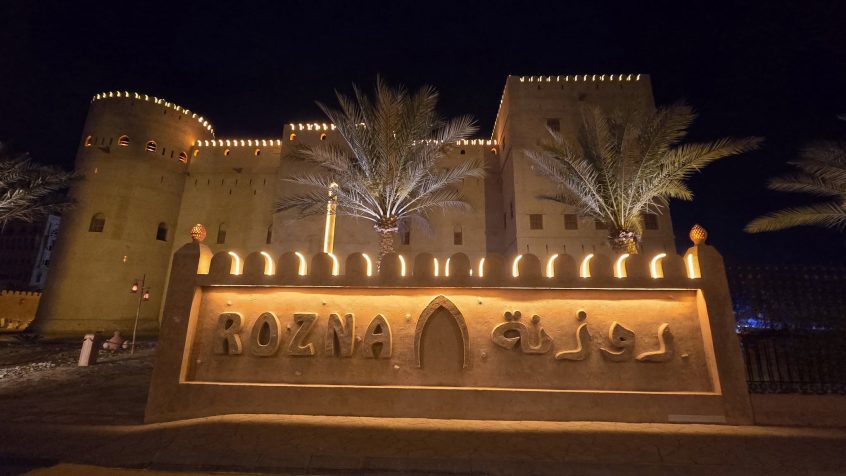This morning I flew on Air Dubai to Muscat. It’s a short flight (50 minutes), but they start boarding very early so I was up and out before I’d had a good night’s sleep. Despite the shortness of the flight, the flight attendants passed out a lunch box. On flights in the states, you probably wouldn’t even get water.
The airport in Muscat is new, efficient, and beautiful, with living green walls. It was lovely to see so many plants. And the roads out of the airport were lined with flowers. Muscat is very different from the other cities I’ve visited on this trip. First, it is mountainous. Second, no buildings are over ten stories tall. That’s to ensure that views of the mountains aren’t blocked.
When I arrived at the hotel, I was tired. I’m still getting over a bad cold. I spent the afternoon sleeping.
But this evening I got a real taste of Omani culture. The driver from the airport recommended a local restaurant, Rozna, designed to look like a historical fort. It does. The food was traditional Omani. The meal started with foods used to break the Ramadan fast (the meal is called Iftar), dates and a yogurt drink. Dinner was served as a buffet and included many Middle Eastern dishes with which I am familiar; hummus, babaganoush, Fattoush salad, and more. Two women were preparing a bread similar to a crepe to order. There were many new foods, most of which I liked.
The house specialty is lamb marinated overnight with traditional spices mixed in date vinegar. It’s then placed wrapped in tree leaves and put into a hole in the ground where it is slowly cooked over hot embers for many hours. Unfortunately, it is cooked for so long it is as dry as the desert. That was, however, the only food I didn’t much like.
Desert included a sweet bean custard, various cakes and a slew of different varieties of baklava.
More interesting than the food was the clientele. There were single sex groups of Omanis sitting together. Only the westerners were sitting in a mixed group. Most of the locals wore traditional dress, abayas for the women (a long cloak that covers them from shoulder to ankles) and a head scarf. Most abayas were plain, but others had elaborate embroidery and beadwork. The men wear a dishdasha, a long collarless robe reaching to the ankles. Sometimes in black, but more often in white. On their heads they wear a cap called a kumma. Everyone, but most especially our waiter Muhammed, were friendly with great smiles.
Back at the hotel, I turned on the TV. There was the usual mix (in Arabic) of talk shows, sports, dramas, cartoons, and movies (Western and Bollywood). The two exceptions were many religious programs and camel racing.
Tomorrow I will explore the city with a local guide.

